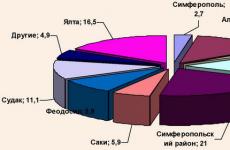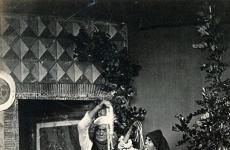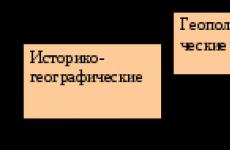What can you make a globe with your hands? DIY globe. Master class. Why is it needed?
Modern manufacturers offer a lot of ready-made night lamps for any theme. Among them, the undoubted bestseller, for many years now, has been night lights that project star clusters on the walls. Indeed, the spectacle is amazing. In general, buying them is not a problem, and they cost very little, considering that the tireless Chinese industry has taken care of a variety of products designed to suit any budget. But you must admit, it’s much more pleasant to make a starry sky with your own hands!
"Tin" stars
We all have empty houses. tin cans from canned food (even if not, getting them is not a problem). The simplest and prettiest lamps are made from them.
To work, you will need an empty can itself without a label, nails, a hammer and a wooden base.
Preparing the jar
To prevent the jar from bending when you punch holes, first fill it with water and freeze it, or stuff it with a thick roll of newspaper.
Take a nail and, without tapping too hard with a hammer, perforate the tin. It is better to use nails of different sizes, then the star scattering will look richer. To make the holes perfectly even, you can drill them randomly using a drill, using drills of different diameters.

Finished product
So that the rays emanating from the “stars” are not scattered by the silvery walls of the can, and the can itself is less conspicuous at night - paint outer part in black. In contrast, each point will become brighter.
You can use these flashlights of different power as a light source.

Light source
They are typically used to illuminate far corners of furniture or closets. These “buttons” operate on regular batteries (you need 3 of them).
You can install simple tablet candles inside, but then do not put such a night light in the nursery. Inhaling candle smoke is harmful, and one careless movement can lead to a fire. Therefore, safe furniture flashlights are an ideal choice.
The finished lamp can be placed on a bedside table or in a gazebo in the garden - it will be very beautiful in the evening.
Sky from a jar
Another simple night light that imitates the starry sky can be made using regular foil and a flask-shaped baby puree jar.

Sky from a jar
So, take a piece of foil. Choose a thicker canvas for these purposes; special, thick foil for embossing is best suited (you can find it in stores for artists or art workshops). To determine required length, wrap the outside of the jar and cut without any allowance. When installed inside the can, we create an extra edge, which will be used to secure the joint.
Now we place the finished cut on a cork or rubber mat and begin to pierce holes with an awl. It is advisable to do them very carefully and in different sizes, this way you will achieve greater realism. You can even look at the map starry sky, reproduce several constellations. Just make the holes larger in diameter so that they immediately catch the eye.
Then roll the workpiece into a “tube” so that the smooth side of the holes faces the front side. Make tucks at the top and bottom and place the foil in the jar.

Preparing the foil
All that remains is to insert the previously mentioned furniture flashlight or LED light bulb inside. They can be installed “facing” both towards the lid and towards the bottom of the jar. In the first case, the flow of light will be more scattered on the sides, making the “stars” brighter. In the second - through the transparent bottom the beam will illuminate the ceiling - why not the Moon?

Final part
Cover the night light with a lid. By the way, you can also make holes in it using a hammer and nail. And then the stars will be projected not only on the walls, but also on the ceiling.
For greater clarity, scratch “paths” between the stars with a needle, putting them into familiar constellations.

Sky from a jar
Even a child can handle such a craft, and you can do it together in half an hour or an hour. original gift friends.
A few more “can” ideas
Using a similar principle, unnecessary tin tea or coffee cans.

Tea can

Original night light
Cans of beer or carbonated drinks are also suitable for the same purposes. Despite the thinness of food-grade aluminum, they are the most difficult to perforate. Since the walls bend strongly with each blow of the hammer. There are two ways to solve this problem:
- cut off the bottom or neck and insert a wooden block inside, but it is not a fact that it will fit tightly to the sides, and with a careless impact one of the sides can be deformed.
- Mix regular sand with water, pour into a jar and place in the freezer until the water freezes. You just shouldn’t pour water - when it freezes, it expands and deforms the walls of the vessel.
Make holes, attach the lantern - voila!
Another idea with elementary execution is a “stardust” night light.
Lubricate inner surface glass jar with transparent silicone glue. Sprinkle it thickly with large sparkles, lightly pressing them into adhesive mass. To distribute them evenly, quickly turn the jar tilted to one side. Let the glue dry overnight and place a candle or flashlight inside. Done, enjoy the result!

Night light "stardust"
This night light scatters glare rather than stars around the room, but still looks very impressive.
Planet "Papier-mâché"

Papier-mâché
For a children's room, you can make your own original papier-mâché lampshade. To do this you will need a regular ball or inflatable ball, PVA glue, a lot of old newspapers and your imagination.
First, simply wet the pieces of newspaper and place them in an even layer on the ball. Next, apply glue and newspaper scraps to the base, layer by layer, to get durable frame. The top layer is best made of plain writing paper or white paper towel so that the printing ink does not show up on the finished product. Let the workpiece dry thoroughly. If desired, you can complement the planet with an asteroid ring, like Saturn.
Carefully cut out dots, curly stars, a month in the surface of the dome - the more there are, the brighter it will be in the nursery. Paint the lampshade, add a lamp and hang it - beauty!

Finished planet
"Sky" at the head
Or you can make not just a night light, but a whole painting-installation on the wall. Stuff a thick dark cloth, cardboard or PVC film onto a wooden frame (metal frame). Underneath it, install a network of non-heating LEDs, attach bundles of fiber-optic “threads” to each of them and thread them into the fabric. If desired, you can even arrange them according to the star map.

Assembling the night light

Old lamp
Optical fibers can be taken from previously popular lamps, like the one below.
In the locations of the “galaxies”, attach bundles of thicker fibers, and complete the rest of the sky with separate “threads”.

"Sky" at the head
The work is very painstaking, but the resulting masterpiece is worth it.
Give me a planetarium!

Blanks
If you are ready to spend about a day making a spectacular lamp, stock up on sheets of thin transparent plastic. If you can’t find ready-made ones, cut out transparent ones. plastic bottles, cutting off the neck, bottom and making one transverse cut. Place the resulting sheets under the press so that they are level.
Cut out a pentahedron pattern from thick paper and start making blanks. You will need eleven of them.
If you have solid sheets plastic, you can cut out the following “pattern” to make assembly easier for yourself later.
Only in the center of the bottom will you need to make a hole to install the lamp.
Now let's start creating the “stars”. Using a spray bottle or a damp brush, randomly spray small drops of water onto the workpieces - they will allow you to leave a scattering of dots unpainted. After that, spray them black paint from a can. Apply it at a distance of about 30 cm so that the pressure of the dye does not sweep away the applied splashes. The layer should be quite dense. Leave the items to dry slightly, usually a couple of minutes, and wipe off any remaining water.

Painting
This is what you should end up with. In the light it is indistinguishable from the real sky at night.

Design element
If you want to achieve even greater realism, you can bend models of constellations from thin wire. Place them on the workpieces before painting and then immediately remove them so that they do not stick when the spray dries.
Now all that remains is to connect all the parts. Using simple tape we assemble our pentahedron night light.

Assembling a pentahedron night light
We install the resulting structure on any base with a light bulb, the main thing is that it does not get too hot and does not touch the walls of the “plafond”. You can use any old lamp or flashlight.
And now we deservedly enjoy the magnificent result after the work done.

It is necessary to perform scrupulous, but interesting job. It is important to find the most suitable card possible and print it. There are many ready-made globe layouts on the Internet. An old political map will also work.
When making a paper globe with your own hands, make sure that the scale of the map and the base on which the map is glued match. You can make the base in several ways.
Globe mockup made from cardboard blanks
For such a globe, you need to patiently and correctly make several pentagonal cardboard blanks. This is the most difficult and responsible part of the work. Their number will depend on the size of each of them. You need to complete the elements according to the diagram.
What to do next, how to make a globe with your own hands from these strange elements? Cut the map into the same elements and glue it with PVA glue onto the cardboard parts of the future globe. You should have a construction kit that can be assembled from spare parts, and which can later be disassembled if you notice that some part has been glued incorrectly. Take your time. All elements must then be assembled in strict sequence so that the copy of the land is correct.

The task is not as difficult as it seems. But, naturally, the child will need the help of an adult to create this interesting model.
How to make a globe with your own hands based on a finished ball
Another blank can be made from ordinary old soccer ball. Just cover the ball with newspaper and apply several layers of paper with glue. Then you can choose one of the options:
1) Glue on the marked and painted globe blank.
2) The child can independently paint the globe.
Suitable for making a globe is any other ball-shaped object you find at home. It could be a toy rubber ball, or a small ball that was a Christmas tree toy. Whatever you want, let the child show his imagination and make a globe with his own hands. Surely he will be proud of this.
Copy of land made of paper
You can also make a globe with your own hands using photo paper. This model will be the most plausible. It will consist of 2 parts: the hemispheres of the North and South. They will then be glued together using a hard strip cardboard paper, which will be the equator.

On good photo paper, print out the full layout of the globe. Preferably with all the continents, with the names of the countries. Cut straight down the center. Then you need to carefully cut out the elements. Their number is 24, in accordance with the number of meridians. Cut out each meridian very carefully so that the globe does not turn out crooked. We begin gluing the sheets at the top, that is, from the poles. Sheets are glued together inside. When you connect all 24 sheets in the center, bend them and secure them to the “equator”. Be sure to number all the sheets on the inside of the paper with a pencil.
When you have completely made the globe with your own hands, come up with a stand for it, and you will have a wonderful copy of the original globe. It is best to cut the stand out of wood. Make the semicircle supporting the axis of the ball thin and not heavy; the stand for it needs a thicker one to support the weight. Make sure that the semicircle is the right size.
Origami globe
Any experienced origami lover can make a globe with his own hands. A master class on making a paper copy of a globe using this technique can be given to a child by a parent.
There are several globe layouts using the origami technique. But most often they make a globe craft in the form of a square “ball”. After all, this craft serves only as a funny decoration, a trinket. There is no respect for scale here. Origami globes are folded for fun.
You can make a real round globe if you make a craft from paper modules. More than 1 thousand modules need to be prepared for the globe. It's much more difficult, but modular origami looks very nice, and your Earth will really be spherical.
Globe for the little ones
Try it for yours small child DIY globe from plastic plates. It's very simple and won't take much time. Just cover 2 plates with patterns and glue them together.

But if you don’t find such a layout, then download the usual one, which only shows the meridians. And then glue the cut out continents on top. On the continents, your child will draw whatever he wants. This is a “trial version” to show your baby what the planet looks like. You can even not glue the meridian layout, but simply glue blue paper depicting the oceans. You can also recommend that your child make continents from plasticine and use superglue to attach them to the plates in the places you indicate.
All the given copies of the Earth are made in order to interest the child and spend time with him. But educational material there will be no such globe, made with your own hands. These crafts are low-precision models. But at the same time, making an entire globe with your own hands - who wouldn’t be interested?
Master class. Globe "Planet of Knowledge"
Making a globe with your own hands using the “Spiderweb” technique. Master class
The master class is designed for children of secondary school age, as well as their parents and teachers.
Every year on the first Saturday of October we celebrate such a wonderful holiday as Teacher's Day. And every year the same question arises: “What gift should I give to my favorite teacher?” Every child wants to please their teacher with something special. Children love making homemade gifts for their teachers. And that's right! Someone will write a poem, someone will draw a still life, and someone will make a postcard with tender wishes. And for those who could not decide which gift is best to make, we present our master class on making a globe with your own hands, using the “Cobweb” technique. First, let's remember what a globe is?
The ball on the stand is a miracle,
Colorful and beautiful.
You can’t count all the colors,
What is on the ball?
There are mountains and seas there,
The ball is magic, they say
Oceans and forests
Such miracles!
And there are many other miracles
I saw it on the ball.
For example, if you want,
You can spin the ball!
On the magic ball
We all have our own home,
Everyone has a route.
The ball's name is GLOBE.
So that you could imagine,
The globe is a copy of the earth!
Well, now I propose to proceed directly to making our miracle gift.
For this we will be needed : crepe paper (blue, green), velvet colored paper, threads (blue, light blue, green), a cup of sour cream, a ball, “Crystal” glue, PVA glue, skewers 6 pcs., alabaster, cotton pad 2 pcs. , button 2 pcs., padding polyester.

To make the “body” of our globe, we will need PVA glue, an inflated ball (medium size), a needle and thread of three colors. We thread a thread into a needle (first blue, then blue and green), pierce a bottle of glue, and stretching the threads through it, we begin to wrap our ball (previously lubricated with Vaseline or any other cream).

After which we need to let our “ball” dry thoroughly.
While it's drying, we'll start making the mount for our globe. To do this, we will take the wire and form it into a frame of the shape and size we need. And then we wrap it tightly with woolen thread.

Our base is ready, which means it’s time to make an “axis” around which everything will revolve. To do this, we will need 6 skewers glued together with “Crystal” glue and wrapped with woolen thread to match our mount.

After complete drying, you can start making the “body” of our globe. The first thing we must do is to remove the ball we don’t need, to do this we pierce it and carefully remove it. Next, fill the “ball” with padding polyester as tightly as possible. We glue the “continents” cut out of velvet colored paper using “Crystal” glue.

We glue the cut-out cotton pads to the places of the supposed “poles”. We also use Crystal glue.

So, all the parts are almost ready, you can start assembling. We put the “body” of the globe on the “axis”, fasten it to the base and secure it at both ends with previously prepared buttons.

Now let's start making the base in which we will subsequently secure our globe.
To do this, wrap a sour cream cup in crepe paper and decorate it with woolen thread.


Well, our wonderful globe is ready!
You can proudly give it to your favorite teacher!!!
Thank you very much for your attention!!!
Creative success to all!
The history of the globe (from the Latin globus - “ball”) goes back a couple of millennia. It’s hard to believe, but nevertheless the first model of the globe was created around 150 BC. ancient Greek philosopher Crathetus of Mallus. Modern globes are different sizes and types, from simple plastic models of the Earth to high-tech digital video globes of the celestial sphere and other planets. But what to do if your old globe has not been used in teaching children for a long time, is tired, takes up space and gathers dust somewhere on a shelf? Don’t rush to throw it away, because with your own hands you can make an original, interesting craft from a globe that will not only decorate your home, but also fulfill functional purpose. Such handmade items bring a little warmth, comfort, romance and travel memories to the interior design.
The most common option for creatively remaking a globe is to create a “geographical” lampshade for a floor, table or ceiling lamp. You can use either one hemisphere or the entire ball. If desired, the edges of the hemisphere can be decorated with braid or some other decor.





Globe lampshades go perfectly with geographical maps on the walls or other travel paraphernalia. For example, a floor lamp with such a lampshade will look harmonious next to a rack containing a collection of souvenirs from different countries. Of course, interior crafts made from globes will always fit well into the interior of a children's room.


It’s easy to assemble a wall clock with your own hands from a globe hemisphere and a clock mechanism.

An original idea is to make a “board” out of a model of the Earth for writing with chalk. This is easy to do by simply painting the globe with special chalkboard paint.

A wooden box, a second unused hemisphere, an applique of newspaper clippings - and the end result is an original composition for the wall that can be presented to a loved one as a gift.

Interior bowl for dead wood, fruit or small items - simple, quick and do it yourself. Such a bowl will support general theme interior decor related to maps and globes.

Well, if a school nearby threw a dozen globes into a landfill - here’s another fun use for them! Geographic snowmen will delight children both in winter and summer!

Source
Today, there are many original master classes on assembling beautiful lamps for the bedroom. In order to make a night light with your own hands at home, sometimes it is not necessary to have special power tools or materials on hand. Some models of homemade nightlights can be assembled from scrap materials in no more than an hour. Next we will look at the simplest and at the same time unusual ideas to make a beautiful lamp on your own.
Idea No. 1 – Starry Sky Projector
So, the very first version of the lamp is a star projector made from a can and a battery-powered flashlight. This homemade option is suitable for both a child’s room and a bedroom. To make a starry sky night light with your own hands, first prepare the following materials:
- glass jar with a lid (it is advisable to find a jar in the shape of a cylinder, and not the usual “pot-bellied” one);
- a sheet of thick foil;
- battery-powered flashlight;
- scissors;
- awl.
The idea is this - you should cut the foil to the height of the jar, hole it over the entire area and place it inside the container. After this, you need to put the switched-on flashlight in the jar and the homemade starry night light is ready, you can turn it on at night and enjoy the atmosphere in the “space” style.
By the way, very important point– in the night sky, children love to look at the constellations Ursa Major and Ursa Minor. It would be nice to make a hole in the foil for these two constellations so that a homemade projector displays the most recognizable constellation for the child on the ceiling. You can make a space night light more like a real starry sky if you punch holes in the foil according to the star arrangement: 
There is an easier way to make a starry night light for a child's room with your own hands - using a very ordinary tin can. All you need is to clean the surface of the jar from the label, paint it suitable color and make a hole with an awl. After this, you can either put a battery-powered flashlight inside the jar, or even just put a lit candle. The latter option will create a more romantic atmosphere in the bedroom. The finished night light should look something like this: 
Idea No. 2 – LED lamp
We recommend viewing another one interesting master class with photo examples of assembling a homemade night light from LEDs. In order to make a beautiful lamp for the nursery, you must prepare the following materials:
- two transparent plastic tubes of different diameters;
- LEDs of suitable brightness and color;
- big traffic jam;
- glass pebbles;
- piece of wire;
- glue;
- pliers;
- board for LEDs;

So, to make the instructions and descriptions clear to you, we will provide you with step-by-step instructions on how to make a night light from scrap materials.

Using this simple technology, you can make an LED night light for a child’s room with your own hands. As you can see, everything is quite simple and it won’t take more than half an hour to create.
Idea No. 3 – Lamp from a can
Well, the last of the original master classes on making a night lamp from scrap materials - using a tea can. In this case, you can make a beautiful night light at home, which is suitable for a child’s room.
So, to get started, prepare the following materials:
- original shaped tea jar;
- a sheet of scrap paper the size of a jar;
- sheet of cardboard;
- stationery knife;
- acrylic paint;
- a piece of sandpaper;
- superglue;
- masking tape;
- light bulb socket;
- ordinary incandescent lamp;
- power cord;
- switch.
Again, it would be more convenient to provide step by step instructions on assembling a homemade night light at home.
- Cut a piece of scrapbooking paper that is the right size to fit completely around the jar. If you choose scrap paper with a pattern, immediately take into account an important point - the top of the night light will be the bottom of the jar.


- Remove the lid from the jar, rest it on a piece of paper, trace it with a pencil and cut it out with a stationery knife.

- Place the cut out template on the jar in suitable place(in the future this will be a window). Secure the paper oval with masking tape and outline with a pencil.

- Cut out the window according to the markings, as shown in the photo.

- Clean the edges with sandpaper.
- Once again, using the oval template, rest it against a piece of cardboard and trace. After that, draw stripes inside the oval, as shown in the photo, and cut out another homemade night light for the nursery.


- Glue the cardboard to the jar on the inside.

- Decorate the outside of the jar using your imagination. You can make a beautiful lamp by decorating it acrylic paints, paper or even thread.

- On the back of the night light, cut a hole for the power cord.


- Cut a hole in the lid of the jar for the lamp socket.

- Assemble a socket with a light bulb, a switch and an electrical plug in one circuit.
- Secure the socket in the jar and screw in the light bulb.



- Assemble a ready-made night light for the nursery and check its functionality. Ideally it should look something like this:


That's all the instructions for assembling a homemade lamp for a child. As you can see, you can even make such beauty at home from scrap materials, if only you have the desire and a little imagination!






